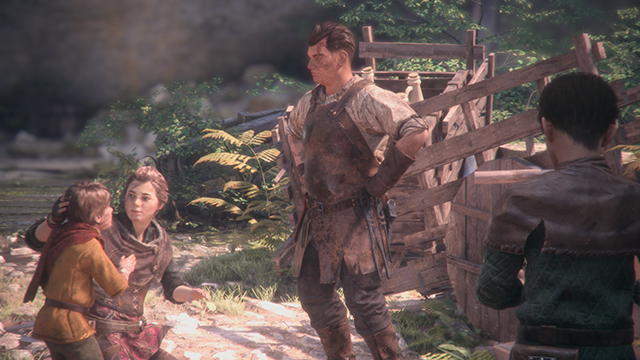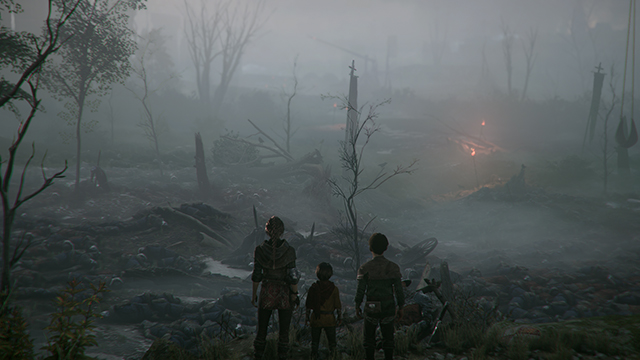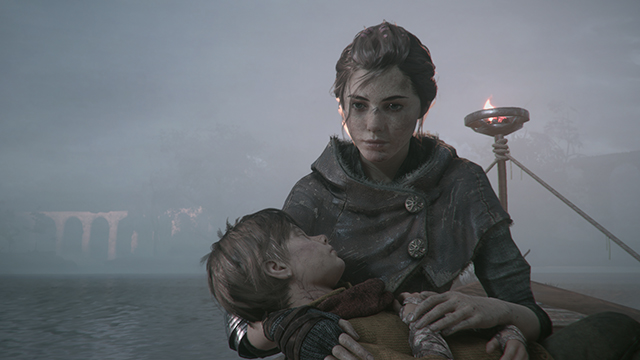A Plague Tale: Innocence didn’t originally come out during a particularly crowded time, but it seemingly still got buried. The title doesn’t spell out exactly what it is out of context and it doesn’t help that it is a new IP from a studio that had mostly done licensed titles or assisted with bigger games in the past. But despite those obstacles, A Plague Tale: Innocence is a heartfelt and special experience players should make an effort to finally get to, given its new native PlayStation 5 and Xbox Series X|S versions.
A Plague Tale: Innocence is quite unique, but has some obvious influences, mainly The Last of Us. Players sneak around and gather crafting materials to build all sorts of different tools and ammunition. Each has a unique effect and while ammo isn’t quite limited, users are encouraged to think carefully about what they use because some powerful items take resources that can be also channeled into permanent upgrades. It’s similar to how shivs worked in the first The Last of Us.
Progression is handled well as most levels offer some new gameplay mechanic or tool. Most of the game is centered around curtailing the hordes of hungry rats or armored guards and even though those are constants, there’s always some sort of twist. However, the gameplay is functional most times, rather unremarkable in others, and only occasionally frustrating. Characters die in one hit and you’re not always afforded the agility, space, or ammo to get out of a jam so tension can flare up and then dissipate rather abruptly. There are some thrilling sequences and some of the pieces of a compelling loop are here, but it doesn’t always come together, which is hopefully something its recently announced sequel, A Plague Tale: Requiem, will address.

But the passable gameplay is not a reason to avoid A Plague Tale: Innocence. The game’s story, characters, and setting are well worth the journey and are still unique two years later. Innocence follows Amicia de Rune, a teenager, and her estranged five-year-old brother, Hugo, as they make their way across France during the plague in 1348. Yes, again, the Last of Us inspirations ring loud and clear.
Her relationship with Hugo is at the center of the game and is a strong foundation to rally around since it gives a grim game so focused on death some much-needed life. Both learn and grow together as their journey gets tougher and tougher, which helps bind them together. Even one of the collectibles has a story significance that shows their camaraderie.
Like Ico’s titular protagonist and Yorda, players often have to hold Hugo‘s hand, but instead of being a chore, it only helps bond the player to their companion. Through these bonds and the care Asobo takes in developing their relationship, players organically feel for Hugo and aren’t only told to do so. While some films can get away with underdeveloping the protagonist’s dependents, games can’t because those dependents can easily become gameplay liabilities. Hugo isn’t initially as strong gameplay-wise as like Ellie in The Last of Us, but at least he isn’t an emotional drag, too.
Even though stories involving children — especially in games — can often be annoying, Innocence humanizes these children and crafts a wonderful tale around them. Adults are hardly the answer here and the small band of young and capable outcasts that slowly join the de Rune crew show the range kids can have if properly realized. They’re mature when they need to be, but also don’t lose sight of their child-like glee and innocence; something the title hints at and the solid performances help bring out.
And while they are great all around, Charlotte McBurney’s Amicia steals the show, making one hell of an impression in her first professional acting role. The story goes cartoonishly nuts by the final act and there are scenes with repetitive, filler dialogue, but these relationships make those shortcomings easy to overlook.

Innocence also looks and runs better than it ever did on consoles. The higher frame rate looks even more smooth and the 4K resolution portrays the beautiful French landscapes and disgusting fantastical locales later in the game in a better light — literally. It doesn’t come close to edging out the most stunning AAA games and the facial animation is more wooden than it should be, but the visuals do their job in appropriately setting the tone. The loading times are probably the biggest noticeable improvement, as they were quite long last time around and just a few seconds on the newer consoles. The PS5’s Dualsense also has better haptic feedback support, as it’ll pop and rumble when rats are near and emulate the weight of Amicia’s sling as she twirls it around.
There are a lot of things about A Plague Tale: Innocence that simply should not work. It’s a long escort quest centered around children from a studio that has hardly made anything but licensed titles most players wouldn’t even play for easy achievements or trophies. But even with its blemishes, A Plague Tale: Innocence is a special title that is all too rare in the gaming space: a narrative-focused, single-player, mid-budget, new IP from a relatively unknown team trying something drastically out of its wheelhouse. With a sequel current-gen-only sequel slated for 2022 and this upgrade being part of PlayStation Plus‘ July lineup and Xbox Game Pass, now is finally the time to finally give Asobo’s most interesting and rat-filled game a shot.










